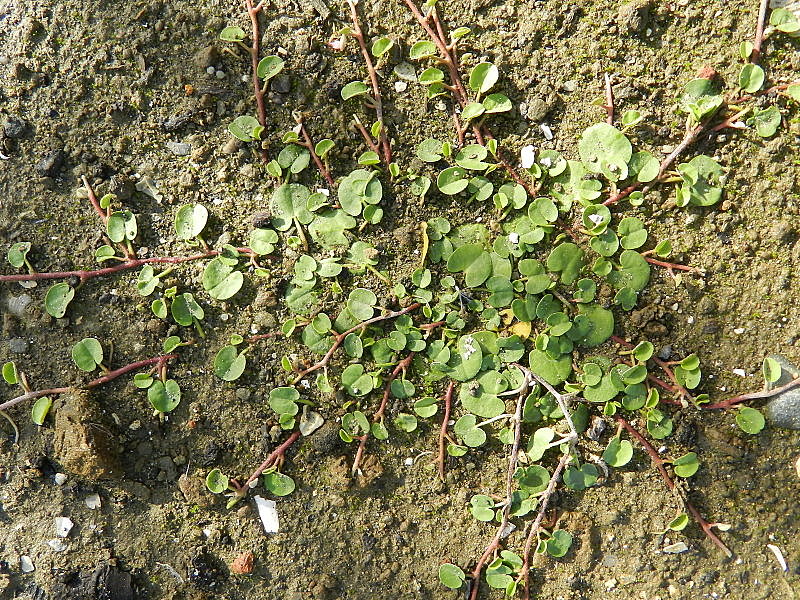Filip Verloove, Botanic Garden of Meise, Belgium
As we know, the unintentional introduction of alien plants can be associated with a wide array of vectors. Well-known introduction vectors that account for huge amounts of aliens are for instance cereals and oil seed crops (‘grain aliens’) and formerly also sheep wool (‘wool aliens’). These days, garden centers and plant nurseries also play an important role in the worldwide dissemination of weeds. Further important vectors are, for instance, timber, various types of ore (e.g. granite, sand), etc. In some instances, however, alien plants can come in in highly unexpected ways. In recent years, for instance, it was shown that lots of southern European species are introduced unintentionally in camping sites, especially in coastal areas where survival rates are higher due to favorable climatic circumstances (see here for an introduction on this issue).
In August 2017 Rutger Barendse explored a recent industrial development adjacent to the Albert canal between Bilzen and Genk (Belgium). The area was obviously raised and for this purpose dredging sludge from river Scheldt was used. In addition to numerous mollusk fossils the vast area was soon covered with emerging weeds that germinated on the rich and fertile soil. It soon became apparent that some of the aliens were far from ordinary: Anoda cristata, several different species of Ipomoea and Abutilon theophrasti. A closer inspection in the following weeks yielded dozens of additional aliens, several never recorded before in Belgium. An illustrated overview of the most interesting species is provided beneath.
Pelargonium candicans: a single individual of this South African species was observed. It has relatively tiny petals and is rather weedy in appearance, mimicking a species of Erodium rather than a Pelargonium. To our knowledge this species has never been recorded outside of its native distribution range.


Dichondra micrantha: at least 5-6 plants were found of this subtropical weed that is sometimes grown as a substitute for lawns in southern Europe. It had not been recorded before in Belgium but was known as a wool alien in the British Isles (Clement & Foster 1994).

Desmanthus aff. virgatus: two saplings were noticed of this subtropical weed, for the first time in Belgium and possibly on the European continent as well.

Other highly exceptional records (all with only very few previous Belgian records) include:
Malvastrum coromandelianum

Ipomoea coccinea

Modiola caroliniana

Further interesting weeds were, among others, Chenopodium probstii, Dracocephalum parviflorum, Hibiscus trionum, Ipomoea hederacea, Ipomoea lacunosa, Ipomoea leucantha, Rumex stenophyllus, Senna obtusifolia, Sesbania exaltata, Sida rhombifolia, Sida spinosa, Solanum aff. nodiflorum, Solanum sisymbriifolium, etc. Many more obviously alien species were observed as young, non-flowering plants and will be raised in climatologically favorable conditions.
 |
 |
 |
 |
 |
 |
 |
 |
To our knowledge dredge spoil deposits are not known to contain high amounts of propagules and a quick search on the internet yields no further information. Yet, in the 1990’s I already received a collection of Ipomoea leucantha that was grown from sludge extracted from docks in the Antwerp port. Although merely anecdotic (there is no chance that any of these subtropical weeds will survive an ordinary Belgian winter) this event is interesting in various ways. Firstly, it reveals a very surprising and totally ignored vector of unintentional plant introductions. Apart from some species that probably came in in other ways (such as Chenopodium div. spec., Rumex stenophyllus, etc.) all species belong to only a few families: Convolvulaceae, Geraniaceae, Leguminosae, Malvaceae and Solanaceae. Members of these families are reputed for their very hard seeds that persist long in buried seed banks, often for many decades (see also Verloove & Heyneman 2012). The composition of the alien flora recently detected in Bilzen and Genk seems to suggest that most of them are associated with soybeans and other oil seeds or cereals. Seeds of these species probably arrived in the docks and river Scheldt during transshipment, sunk to the bottom of the river and became part of the sediment, possibly for quite a long time. The total absence of weeds from species-rich families such as Asteraceae and Amaranthaceae indeed point at seeds that were extracted from a long-persisting seedbank. This, however, only explains part of this unexpected event. Pelargonium candicans is not a genuine weed, has a rather restricted native distribution in South Africa and is only very exceptionally grown as an ornamental, if at all. How and why it popped up on a dredge spoil deposit in Belgium will probably always remain an enigma…
References
Clement E.J. & Foster M.C. (1994) Alien plants of the British Isles. BSBI, London: XVIII + 590 p.
Verloove F. & Heyneman G. (2012) Remarkable plant collections from two anthropogenic seed banks in Ghent (prov. of Oost-Vlaanderen, Belgium) (in Dutch). Dumortiera 100: 19-24. [available online at: http://www.br.fgov.be/DUMORTIERA/DUM_100/Dum%20100_19-24_Zaadbanken%20Ge...

